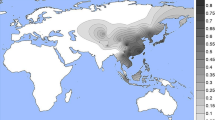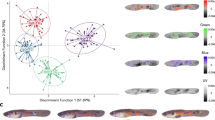Abstract
The X-linked red- and green-pigment genes are arranged in a head-to-tail tandem array1,2,3. The colour-vision defect of deuteranomaly (in 5% of males of European descent) is associated with a 5´-green-red-3´ visual-pigment hybrid gene4,5, which may also exist in males with normal colour vision5,6,7. To explain why males with a normal red, a normal green and a green-red hybrid gene may have either normal or deutan colour vision, we hypothesized that only the first two genes are expressed8,9 and deuteranomaly results only if the green-red hybrid gene occupies the second position and is expressed preferentially over normal green-pigment genes occupying more distal positions. We used long-range PCR amplification and studied 10 deutan males (8 deuteranomalous and 2 deuteranopic) with 3 visual pigment genes (red, green and green-red hybrid) to investigate whether position of the hybrid gene in the array determined gene expression. The green-red hybrid gene was always at the second position (and the first position was always occupied by the red gene). Conversely, in two men with red, green and green-red hybrid genes and normal colour vision, the hybrid gene occupied the third position. When pigment gene mRNA expression was assessed in post-mortem retinae of three men with the red, green and green-red genotype, the green-red hybrid gene was expressed only when located in the second position. We conclude that the green-red hybrid gene will only cause deutan defects when it occupies the second position of the pigment gene array.
This is a preview of subscription content, access via your institution
Access options
Subscribe to this journal
Receive 12 print issues and online access
$209.00 per year
only $17.42 per issue
Buy this article
- Purchase on Springer Link
- Instant access to full article PDF
Prices may be subject to local taxes which are calculated during checkout




Similar content being viewed by others
References
Nathans, J., Thomas, D. & Hogness, D.S. Molecular genetics of human color vision: the genes encoding blue, green, and red pigments. Science 232 , 193–202 (1986).
Vollrath, D., Nathans, J. & Davis, R.W. Tandem array of human visual pigment genes at Xq28. Science 240, 1669–1672 (1988).
Feil, R., Aubourg, P., Heilig, R. & Mandel, J.L. A 195-kb cosmid walk encompassing the human Xq28 color vision pigment genes. Genomics 6, 367–373 ( 1990).
Nathans, J., Piantanida, T.P., Eddy, R.L., Shows, T.B. & Hogness, D.S. Molecular genetics of inherited variation in human color vision. Science 232, 203–210 (1986).
Deeb, S.S. et al. Genotype-phenotype relationships in human red/green color-vision defects: molecular and psychophysical studies. Am. J. Hum. Genet. 51, 687–700 ( 1992).
Drummond-Borg, M., Deeb, S.S. & Motulsky, A.G. Molecular patterns of X chromosome-linked color vision genes among 134 men of European ancestry. Proc. Natl Acad. Sci. USA 86, 983–987 ( 1989).
Neitz, M. & Neitz, J. Numbers and ratios of visual pigment genes for normal red-green colour vision. Science 267 , 1013–1016 (1995).
Winderickx, J., Battisti, L., Motulsky, A.G. & Deeb, S.S. Selective expression of human X chromosome-linked green opsin genes. Proc. Natl Acad. Sci. USA 89, 9710– 9714 (1992).
Yamaguchi, T., Motulsky, A.G. & Deeb, S.S. Visual pigment gene structure and expression in human retinae. Hum. Mol. Genet. 6, 981– 990 (1997).
Crognale, M.A., Teller, D.Y., Motulsky, A.G. & Deeb, S.S. Severity of color vision defects: electroretinographic (ERG), molecular and behavioral studies. Vision Res. 38, 3377 –3385 (1998).
Farrell, D.F., Hamilton, S.R., Knauss, T.A., Sanocki, E. & Deeb, S.S. X-linked adrenoleukodystrophy: adult cerebral variant. Neurology 43, 1518– 1522 (1993).
Hanna, M.C., Platts, J.T. & Kirkness, E.F. Identification of a gene within the tandem array of red and green color pigment genes. Genomics 43, 384–386 (1997).
Merbs, S.L. & Nathans, J. Absorption spectra of the hybrid pigments responsible for anomalous color vision. Science 258, 464–466 (1992).
Asenjo, A.B., Rim, J. & Oprian, D.D. Molecular determinants of human red/green color discrimination. Neuron 12, 1131–1138 (1994).
Sjoberg, S.A., Neitz, M., Balding, S.D. & Neitz, J. L-cone pigment genes expressed in normal color vision. Vision Res. 38, 3213–3219 (1998).
Neitz, J., Neitz, M. & Kainz, P.M. Visual pigment gene structure and the severity of color vision defects. Science 274, 801– 804 (1996).
Shevell, S.K. & He, J.C. The visual photopigments of simple deuteranomalous trichromats inferred from color matching. Vision Res. 37, 1115–1127 ( 1997).
Sharpe, L.T. et al. Red, green, and red-green hybrid pigments in the human retina: correlations between deduced protein sequences and psychophysically measured spectral sensitivities. J. Neurosci. 18, 10053–10069 (1998).
Nathans, J. et al. Genetic heterogeneity among blue-cone monochromats. Am. J. Hum. Genet. 53, 987–1000 (1993).
Wang, Y. et al. A locus control region adjacent to the human red and green visual pigment genes. Neuron 9, 429– 440 (1992).
Hanscombe, O. et al. High-level, erythroid-specific expression of the human α-globin gene in transgenic mice and the production of human hemoglobin in murine erythrocytes. Genes Dev. 3, 1572–1581 (1989).
Dillon, N. & Grosveld, F. Human γ-globin genes silenced independently of other genes in the β-globin locus. Nature 350, 252–254 ( 1991).
Sanocki, E., Teller, D.Y. & Deeb, S.S. Rayleigh match ranges of red/green color-deficient observers: psychophysical and molecular studies. Vision Res. 37, 1897–1907 (1997).
Kitahara, K. Individual variations in color vision and its molecular biology. Nippon Ganka Gakkai Zasshi 102, 837– 849 (1998).
Miller, S.A., Dykes, D.D. & Polesky, H.F. A simple salting out procedure for extracting DNA from human nucleated cells. Nucleic Acids Res. 16, 1215 (1988).
Macke, J.P. & Nathans, J. Individual variation in size of the human red and green visual pigment gene array. Invest. Ophthalmol. Vis. Sci. 38, 1040–1043 (1997).
Acknowledgements
We thank K. Kitahara and T. Yamaguchi for subject 6 DNA. This work was supported by NIH grant EY08395. T.H. was supported by a fellowship from the Department of Ophthalmology, Jikei University School of Medicine.
Author information
Authors and Affiliations
Corresponding author
Rights and permissions
About this article
Cite this article
Hayashi, T., Motulsky, A. & Deeb, S. Position of a 'green-red' hybrid gene in the visual pigment array determines colour-vision phenotype. Nat Genet 22, 90–93 (1999). https://doi.org/10.1038/8798
Received:
Accepted:
Issue Date:
DOI: https://doi.org/10.1038/8798
This article is cited by
-
Color vision diversity and significance in primates inferred from genetic and field studies
Genes & Genomics (2016)
-
Gene conversion and purifying selection shape nucleotide variation in gibbon L/M opsin genes
BMC Evolutionary Biology (2011)



